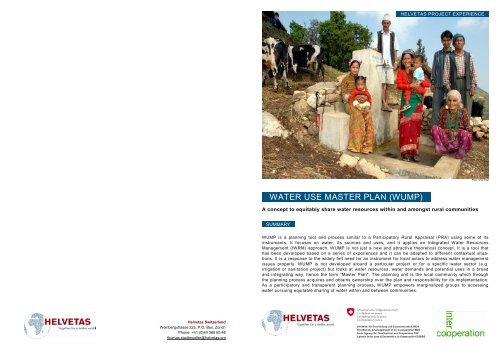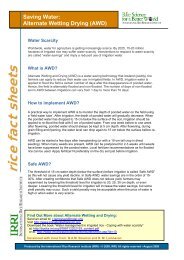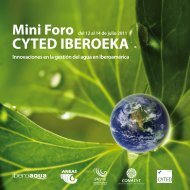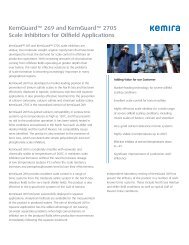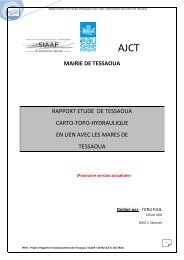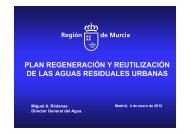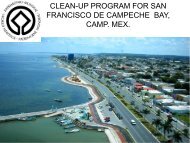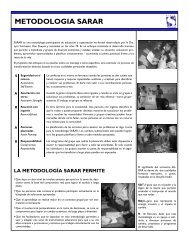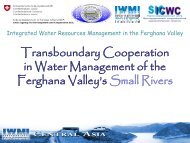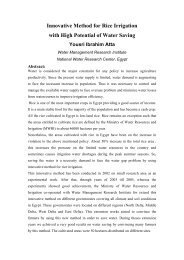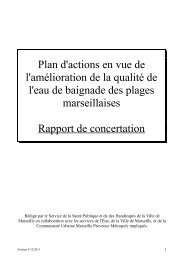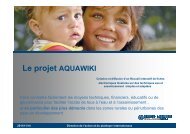water use master plan (wump) - Solutions for Water platform - World ...
water use master plan (wump) - Solutions for Water platform - World ...
water use master plan (wump) - Solutions for Water platform - World ...
Create successful ePaper yourself
Turn your PDF publications into a flip-book with our unique Google optimized e-Paper software.
!!!HELVETAS PROJECT EXPERIENCE!!!<br />
Photo: Silvia Voser<br />
WATER USE MASTER PLAN (WUMP)III<br />
A concept to equitably share <strong>water</strong> resources within and amongst rural communities<br />
SUMMARY!!!<br />
WUMP is a <strong>plan</strong>ning tool and process similar to a Participatory Rural Appraisal (PRA) using some of its<br />
instruments. It foc<strong>use</strong>s on <strong>water</strong>, its sources and <strong>use</strong>s, and it applies an Integrated <strong>Water</strong> Resources<br />
Management (IWRM) approach. WUMP is not just a new and attractive theoretical concept. It is a tool that<br />
has been developed based on a series of experiences and it can be adapted to different contextual situations.<br />
It is a response to the widely felt need <strong>for</strong> an instrument <strong>for</strong> local actors to address <strong>water</strong> management<br />
issues properly. WUMP is not developed around a particular project or <strong>for</strong> a specific <strong>water</strong> sector (e.g.<br />
irrigation or sanitation project) but looks at <strong>water</strong> resources, <strong>water</strong> demands and potential <strong>use</strong>s in a broad<br />
and integrating way, hence the term "Master Plan". The <strong>plan</strong>ning unit is the local community which through<br />
the <strong>plan</strong>ning process acquires and obtains ownership over the <strong>plan</strong> and responsibility <strong>for</strong> its implementation.<br />
As a participatory and transparent <strong>plan</strong>ning process, WUMP empowers marginalized groups to accessing<br />
<strong>water</strong> pursuing equitable sharing of <strong>water</strong> within and between communities.<br />
Helvetas Switzerland<br />
Weinbergstrasse 22a, P.O. Box, Zürich<br />
Phone: +41 (0)44 368 65 46<br />
thomas.stadtmueller@helvetas.org
CONTENT!!!<br />
1. Purpose<br />
2. Principles<br />
3. Process<br />
4. People<br />
5. Products<br />
6. Potential and Challenges<br />
7. Perspectives<br />
!!!1. PURPOSE!!!<br />
The purpose of a <strong>Water</strong> Use Master Plan (WUMP) is to<br />
achieve an effective, equitable and efficient <strong>use</strong> of <strong>water</strong> on a<br />
local level. The goal of developing a WUMP is to delegate<br />
<strong>water</strong> <strong>plan</strong>ning and management to the community level, and<br />
by doing so to ensure that <strong>water</strong> resources are <strong>use</strong>d rationally<br />
and shared equitably and fairly among and within<br />
communities in a sustainable way considering all different<br />
needs.<br />
Specific objectives are (a) to identify <strong>water</strong> resources and<br />
related infrastructures/facilities, (b) establish priorities of<br />
potential activities in the <strong>water</strong> sector, (c) achieve sound and<br />
long-term investment in the <strong>water</strong> sector, and (d) promote<br />
conservation of <strong>water</strong> resources and natural resources linked<br />
to <strong>water</strong>.<br />
Furthermore, there are two important additional purposes:<br />
(a) to establish synergies with decentralization processes and<br />
(b) to <strong>use</strong> <strong>water</strong> as a common resource as catalyst <strong>for</strong><br />
capacity development in a stepwise learning by doing<br />
process.<br />
2. PRINCIPLES!!!<br />
Based on an Integrated <strong>Water</strong> Resources Management<br />
(IWRM) approach, a WUMP is developed through a<br />
participatory, mainly bottom up <strong>plan</strong>ning process. It stresses<br />
consensus building among community members and<br />
between communities that <strong>water</strong> resources need to be shared<br />
equitably and fairly in a sustainable manner <strong>for</strong> different <strong>use</strong>s.<br />
The WUMP process emphasizes the inclusion and<br />
responsibility of all stakeholders in the <strong>plan</strong>ning, negotiation<br />
and in decision making, and there<strong>for</strong>e it improves local governance.<br />
Thus it empowers the marginalized members of a<br />
community and restrains the powerful ones. WUMP adheres<br />
to the following principles:<br />
• The development and <strong>use</strong> of WUMPs has been<br />
tested so far mainly in Nepal. There<strong>for</strong>e, the<br />
concept needs to be piloted elsewhere too. in<br />
various countries outside Nepal. The In order to<br />
provide sufficient in<strong>for</strong>mation to decision makers<br />
about detailed requirements, conditions, costs and<br />
impacts of WUMP, more experiences are needed.<br />
These experiences will improve knowledge on how<br />
the promising concept and methodology of WUMP<br />
can be adapted and implemented most properly in<br />
different contextual situations.<br />
• WUMP can and should be <strong>use</strong>d to address <strong>water</strong><br />
productivity in agriculture. Agriculture can <strong>use</strong> <strong>water</strong><br />
more efficiently than present practices indicate. And<br />
local communities and local governments can play a<br />
vital role in <strong>water</strong> <strong>use</strong> and agriculture. Technology<br />
<strong>for</strong> efficient transport of <strong>water</strong> from the site of<br />
abstraction to the field, and <strong>for</strong> delivering it to the<br />
crop <strong>plan</strong>ts with a minimum of losses, is available -<br />
at a cost - and is being progressively applied where<br />
<strong>water</strong> is scarce (and financial resources are made<br />
available). Irrigation-<strong>water</strong>-<strong>use</strong> efficiency increases<br />
when the right policy <strong>plan</strong>s and market incentives<br />
are in place.<br />
!!!7. PERSPECTIVES!!!<br />
Promoting WUMP is a response to a widely felt need <strong>for</strong><br />
an instrument <strong>for</strong> local actors to address <strong>water</strong><br />
management issues in a proper and integrated way. As<br />
a highly participatory tool and method around <strong>water</strong>, a<br />
crucial and common good, preparing a WUMP will not<br />
only improve the management of <strong>water</strong> resources but<br />
also the mechanisms of good local governance.<br />
The increasing demands on <strong>water</strong> <strong>for</strong> different <strong>use</strong>s, the<br />
growing population in many rural areas, and the challenges<br />
of climate change (changes in rainfall patterns and<br />
hydrological regimes), require a <strong>plan</strong>ning and management<br />
tool such as WUMP to cope with these challenges<br />
on local level.<br />
It is hoped that in the future, experiences from different<br />
regions will help to develop WUMP further. Helvetas,<br />
Intercooperation and the <strong>water</strong>-<strong>for</strong>-food exchange<br />
plat<strong>for</strong>m will support this process of exchange and<br />
improvement further.<br />
Photo: Silvia Voser<br />
!!!CREDITS!!!<br />
<strong>Water</strong> Resources Management Programme (WARM-P), Nepal<br />
The WUMP concept and tool was originally developed in Nepal by the <strong>Water</strong> Resources Management Programme (WARM-P)<br />
which capitalizes on the 30 years’ experiences of Helvetas in the <strong>water</strong> sector in Nepal. WARM-P has moved from supporting<br />
communities <strong>for</strong> drinking <strong>water</strong> and sanitation towards facilitating the preparation of <strong>Water</strong> Use Master Plans at village level, which<br />
has been an important step towards Integrated <strong>Water</strong> Resources Management. Most <strong>water</strong> systems in the hilly areas are gravity<br />
flow systems using natural spring <strong>water</strong>. The sources may be <strong>use</strong>d or claimed by several hamlets <strong>for</strong> different purposes. Thus,<br />
<strong>water</strong> resources <strong>plan</strong>ning at local level, using WUMP, is an essential step towards sustainable and equitable resource management.<br />
Community of Practice “<strong>Water</strong>-<strong>for</strong> Food”<br />
The Community of Practice “<strong>Water</strong>-<strong>for</strong> Food” is a network and discussion plat<strong>for</strong>m of interested people who wish to capitalize<br />
experience, share and create new knowledge and innovations. The Community of Practice works, facilitates and fosters exchange<br />
of experiences through an electronic plat<strong>for</strong>m (www.<strong>water</strong>-<strong>for</strong>-food.ch) and face-to-face meetings. The overall topic is "Sustainable<br />
<strong>use</strong> of <strong>water</strong> resources <strong>for</strong> food production within the concept of Integrated <strong>Water</strong> Resource Management in developing and<br />
transition countries". Within this context, the <strong>Water</strong> Use Master Plan (WUMP), as presented here, has been further discussed and<br />
developed as a concept which should be adaptable and applicable under different geographic, biophysical, socio-economic and<br />
institutional conditions.<br />
Individual professionals from several countries<br />
The process of developing this document included a series of special exchanges between experts from several countries and<br />
professional backgrounds. Finally, a special write-shop was organized in Mali to bring them together <strong>for</strong> developing a first draft of<br />
the document. In this regard, special thanks go to Madan Bhatta, Ramesh Bohara and Rhade Bhistra (all from Nepal), Shailendra<br />
Twari and Devanshu Chakravarti (from India), Albert Grela (from Belgium) and Martin Fischler, Chris Morger, Gian Nicolay and<br />
Thomas Stadtmüller (all from Switzerland).<br />
.........................................................................<br />
Boy drinking <strong>water</strong> in Shatibazaar in Nepal<br />
.........................................................................
Outcome 5: <strong>Water</strong> losses are identified and possible<br />
measures are proposed to improve efficiency and productive<br />
<strong>use</strong> (as often large volumes of valuable <strong>water</strong> are lost due to<br />
improper <strong>use</strong>, illegal connections from the main line, leakages<br />
in pipes and by not using excess and run-off <strong>water</strong>). Improper<br />
<strong>use</strong> of <strong>water</strong> is not only a technical issue. Often it is ca<strong>use</strong>d<br />
by lack of awareness, inappropriate behaviour and lack of<br />
ownership.<br />
Outcome 6: Capacity requirements and training needs are<br />
assessed and measures are taken to develop necessary<br />
capacities. Preparing a WUMP may involve local NGOs;<br />
individuals may be involved in facilitating and implementing<br />
<strong>water</strong> and sanitation or irrigation projects together with<br />
community members, and training them <strong>for</strong> operation, repair<br />
and maintenance at the same time.<br />
Outcome 7: A knowledge base is created where in<strong>for</strong>mation<br />
is stored in an appropriate <strong>for</strong>m <strong>for</strong> further development of the<br />
<strong>plan</strong> and <strong>for</strong> other development activities.<br />
6. POTENTIAL & CHALLENGES!!<br />
Experiences with preparing a WUMP, particularly in Nepal,<br />
have shown a series of potentials as outlined above. Yet<br />
there are also challenges to overcome:<br />
• Lessons learnt from WUMP exercises are promising<br />
but need still to be refined. The strong interest <strong>for</strong><br />
the WUMP <strong>plan</strong>ning process will hopefully lead to a<br />
better understanding of its value and its impacts.<br />
Cost-efficiency considerations shall help decisionmakers<br />
to consider this tool <strong>for</strong> development of<br />
<strong>water</strong>-related investments.<br />
• Quality issues need to be addressed, in order to<br />
make the preparation of WUMP a reliable process.<br />
Criteria and standards need to be developed, which<br />
assure that the process and its particular steps are<br />
followed properly and in accordance with the WUMP<br />
concept and philosophy.<br />
Photo: Stefan Stolle<br />
• The WUMP process is community managed.<br />
The needs and interests of the community are the<br />
starting-point <strong>for</strong> launching a WUMP process. The<br />
main partner <strong>for</strong> developing a WUMP is the<br />
(elected) local government body of the community.<br />
All stakeholders must agree to develop a WUMP<br />
and must be willing to cooperate. If considered<br />
necessary, a <strong>water</strong> resources management committee<br />
may be <strong>for</strong>med at the local level, in which all<br />
different groups of the community are legitimately<br />
represented.<br />
• The WUMP process is bottom-up. Through this<br />
process sub-committees can be <strong>for</strong>med to develop<br />
specific topics (e.g. to conduct social mapping or<br />
prepare <strong>water</strong> source inventories).<br />
• The WUMP process is inclusive. The WUMP<br />
process is built upon the principle of creating<br />
socially inclusive community <strong>for</strong>ums that develop<br />
the <strong>plan</strong>. Membership in committees is not simply<br />
tokenistic or symbolic. The active participation of<br />
women and marginalized groups is required and<br />
promoted accordingly. External facilitation may<br />
provide coaching and support to ensure that all<br />
stakeholders can raise their voice and articulate<br />
their concerns.<br />
• Local capacities are strengthened. External<br />
facilitation may also support committees headed by<br />
local leaders. Empowerment and capacity building<br />
of disadvantaged groups through various trainings<br />
will enhance broad ownership and improve<br />
inclusiveness and sustainability.<br />
• Awareness on key issues is enhanced.<br />
Key issues such as ensuring sustainability of <strong>water</strong><br />
supply through source protection and good<br />
management, minimizing <strong>water</strong> wastage and setting<br />
priorities (<strong>water</strong> savings, <strong>water</strong> <strong>for</strong> crops, <strong>water</strong> <strong>for</strong><br />
livestock, increase availability, control etc.) require<br />
room <strong>for</strong> dialogue of different perceptions and<br />
negotiation of conflicting interests.<br />
• Balancing <strong>water</strong> supply and demand. Managing<br />
<strong>water</strong> sustainably is essentially balancing demand<br />
with the available supply. Trade-offs are often<br />
necessary between different <strong>use</strong>s and <strong>use</strong>rs, and<br />
priorities have to be jointly decided.<br />
3. PROCESS!!!<br />
A WUMP has to be practical, adapted to the local and<br />
national institutional framework, sensitive to cultural and<br />
social conditions and technologically appropriate. There<strong>for</strong>e,<br />
guidelines are <strong>for</strong>mulated here in rather general terms. They<br />
should be seen as basic elements which need appropriate<br />
and careful interpretation and adaptation to the local context.<br />
Communities may need support to acquire the institutional<br />
and technical capacity to <strong>plan</strong> <strong>water</strong> <strong>use</strong> and manage <strong>water</strong><br />
projects responsibly. The central element of a WUMP<br />
process is to ensure inclusive participation and ownership,<br />
particularly of women and members of marginalized and<br />
disadvantaged groups (e.g. ethnic or religious minorities,<br />
tribes).<br />
Key element of the <strong>plan</strong>ning process is a comprehensive<br />
inventory of resources, infrastructure facilities, institutions and<br />
power relations through the communities themselves. This<br />
inventory must be objective, broad, participatory and creating<br />
local ownership. The WUMP process will include the following<br />
activities or steps, which reflect the overall “inventory character”<br />
mentioned above:<br />
• initiate the process by facilitating community meetings,<br />
providing support in capacity development<br />
and confidence building;<br />
• carry out an inventory of all existing <strong>water</strong> sources,<br />
including an assessment of the in situ conservation<br />
and rain <strong>water</strong> harvesting potential;<br />
• assess <strong>water</strong> availability and quality of each source<br />
throughout the seasons, and determine whether the<br />
source is protected or whether it can be further<br />
developed;<br />
• determine who has access to <strong>water</strong> sources and<br />
how <strong>water</strong> is allocated and point out if there are<br />
differences of access based on different groups or<br />
gender;<br />
• highlight existing or potential conflicts over <strong>water</strong><br />
within the community but also with neighbouring<br />
communities; if inter-communal conflicts exist,<br />
include the communities in the negotiations;<br />
• visualize upstream and downstream <strong>use</strong>r rights and<br />
conflicts;<br />
• analyse the potential <strong>for</strong> the development of<br />
different <strong>water</strong> sources and <strong>for</strong> <strong>water</strong> harvesting;<br />
........................................................................................................................................<br />
Farmer checking <strong>water</strong> flow in an irrigation channel in Kyrgyzstan, Central Asia<br />
........................................................................................................................................<br />
• assess existing capacities <strong>for</strong> <strong>water</strong> development,<br />
operations and management, and possible needs<br />
<strong>for</strong> capacity building and training.
• create awareness <strong>for</strong> hygiene and sanitation<br />
through role plays, street theatre etc.<br />
• analyse <strong>water</strong> needs <strong>for</strong> the different <strong>water</strong><br />
<strong>use</strong>s/sectors<br />
• discuss, negotiate and set priorities <strong>for</strong> <strong>water</strong> <strong>use</strong><br />
considering <strong>water</strong> allocation <strong>for</strong> people, sanitation,<br />
livestock, food production, fisheries and other <strong>use</strong>s<br />
• discuss and determine what kind of infrastructure<br />
would be needed and make a rough estimate of its<br />
cost<br />
• assess who would benefit and / or contribute; who<br />
would loose, and how they can be compensated<br />
• discuss possible funding sources, create awareness<br />
<strong>for</strong> community contribution, operating cost and cost<br />
recovery<br />
Having concluded this process, a feasibility study needs to be<br />
done <strong>for</strong> the infrastructure required (survey, <strong>plan</strong> and cost<br />
estimate). For this a consultant / engineer or NGO has to be<br />
contracted by the community. The feasibility study needs to<br />
be discussed in the community with special emphasis on<br />
available resources and funding options. Funds need to be<br />
mobilised and secured from different sources be<strong>for</strong>e a<br />
decision is taken. Funding via the local government needs to<br />
consider legal implications.<br />
4. PEOPLE!!!<br />
Main stakeholders of the process are:<br />
• Communities <strong>plan</strong> <strong>water</strong> <strong>use</strong> and manage <strong>water</strong><br />
projects in a participatory, responsible and socially<br />
inclusive way.<br />
• Local authorities are closely involved in the WUMP<br />
process to assure commitment, ownership and<br />
endorsement.<br />
• Local service providers support communities and<br />
committees in the social and technical work.<br />
Photo: Sandra Kuenzle<br />
The role of NGOs or development projects is to facilitate the<br />
<strong>plan</strong>ning process and, once a <strong>plan</strong> is established, to support<br />
communities to access funds from Governments or donors <strong>for</strong><br />
implementation. It is important that local authorities are<br />
closely involved in the WUMP process and that linkages with<br />
relevant partners and line agencies are rein<strong>for</strong>ced. WUMP<br />
has the potential to enhancing local capacities in participatory<br />
and socially inclusive <strong>plan</strong>ning. It can become a ”marketing<br />
tool” <strong>for</strong> acquiring financial and human resources <strong>for</strong><br />
implementing the schemes which have been <strong>plan</strong>ned.<br />
5. PRODUCTS!!!<br />
The main product of the panning process is a <strong>master</strong> <strong>plan</strong><br />
owned by local stakeholders who are committed to put it<br />
properly into practice. The <strong>plan</strong> contains a <strong>water</strong> budget<br />
(supply/demand) and includes agreements on the allocation<br />
and the <strong>use</strong> of the available <strong>water</strong>. It specifies how to<br />
minimise <strong>water</strong> losses and how to increase productive <strong>water</strong><br />
<strong>use</strong> without negative effects on the environment and<br />
downstream communities.<br />
The <strong>plan</strong> provides also guidelines <strong>for</strong> annual and periodic<br />
<strong>plan</strong>ning and prioritization of activities by local bodies /<br />
authorities. It enables stakeholders to easily and regularly<br />
update the inventories of <strong>water</strong> resources and <strong>water</strong> related<br />
infrastructure/facilities. It is also a tool to approach donors<br />
and Government agencies to cooperate and to contribute or<br />
invest. On the social level a local plat<strong>for</strong>m <strong>for</strong> <strong>water</strong> <strong>plan</strong>ning<br />
is set up to ensure equal access to <strong>water</strong> resources <strong>for</strong><br />
legitimate and basic needs. Besides the <strong>plan</strong> itself, there are<br />
important outcomes of a WUMP process, both on technical<br />
as well as on social level:<br />
Outcome 1: Disadvantaged groups participate on equal<br />
terms in the <strong>plan</strong>ning, negotiation and decision making of<br />
<strong>water</strong> resources of a community. The basic needs of all<br />
members of a community, including the poor and disadvantaged<br />
groups are considered.<br />
Outcome 2: People are aware of the social as well as the<br />
economic value of <strong>water</strong>, realizing that supplying <strong>water</strong> and<br />
maintaining the system creates costs. But, <strong>water</strong> also<br />
provides opportunities <strong>for</strong> generating income, e.g. through<br />
irrigation, or small scale economic activities.<br />
!!!A TYPICAL WUMP!!!<br />
The components of a typical WUMP would be:<br />
• Inventory of available <strong>water</strong> resources and their<br />
current <strong>use</strong>:<br />
a) Available <strong>water</strong> resources (rivers, lakes, ground<strong>water</strong><br />
etc) with <strong>water</strong> rights <strong>for</strong> each source)<br />
b) Existing situation of <strong>water</strong> <strong>use</strong>, quality, allocation<br />
and existing / potential conflicts<br />
c) Service level of facilities / systems and their<br />
functional status<br />
• Socio-economic baseline in<strong>for</strong>mation (disaggregated<br />
by gender, cast or other relevant group criteria)<br />
to provide in<strong>for</strong>mation <strong>for</strong> projected <strong>water</strong> needs:<br />
a) Demographic data<br />
b) Number of domestic animals<br />
c) Access to / needs <strong>for</strong> <strong>water</strong>, sanitation, health,<br />
education, etc.<br />
d) Land holdings<br />
e) Health, hygiene and sanitation situation<br />
f) Income activities<br />
g) Small rural enterprises<br />
h) Capacities, resources, opportunities, services<br />
i) Planned and ongoing community projects<br />
• A balanced <strong>water</strong> resources development <strong>plan</strong> with<br />
due consideration of sanitation and <strong>water</strong> rights and<br />
social, environmental and economic sustainability<br />
criteria<br />
• Gender sensitive, inclusive, pro-poor and socially<br />
accepted <strong>water</strong> development priorities of the<br />
communities<br />
• Preliminary design and costing of potential investments<br />
or other activities such as capacity building<br />
Outcome 3: The need <strong>for</strong> environmental sustainability and<br />
source protection is recognized. Communities act accordingly<br />
and take care of the conservation of <strong>water</strong> sources and<br />
catchment areas by protecting sources and taking restoration<br />
measures where required.<br />
• Assignment of responsibilities <strong>for</strong> the implementation<br />
of the <strong>plan</strong> and eventually the establishment of<br />
new institutions<br />
....................................................................................................................................<br />
Inhabitants of Balama, Mozambique get excited about the drinking <strong>water</strong> well<br />
....................................................................................................................................<br />
Outcome 4: Women’s role as “<strong>water</strong> managers” is properly<br />
taken into account, since in many cases women take<br />
traditionally care of <strong>water</strong> issues and carry corresponding<br />
responsibilities. As the WUMP process encourages and<br />
enables women to participate in meetings/workshop and be<br />
represented in committees where they take actively part in<br />
decisions, it empowers them and contributes to improving<br />
their position within the community.


